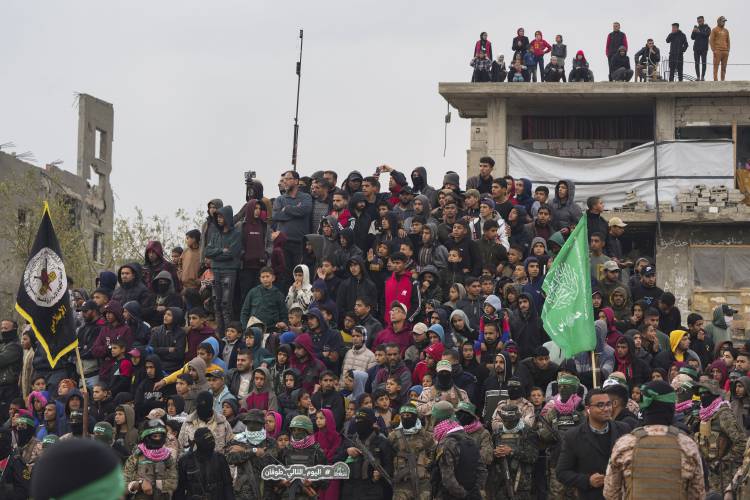Columnist Richard Fein: Gaza — What kind of future will there be?
| Published: 02-27-2025 11:03 AM |
The first stage of an Israel/Hamas ceasefire has been in effect for several weeks. About 600 humanitarian relief trucks are able to enter Gaza daily. There is a slow but steady exchange of hostages and prisoners between Israel and Hamas. Negotiations for a second stage of the ceasefire are scheduled.
If successful, all Israeli hostages, living or dead, will be set free. Stage three of the ceasefire calls for an end to the war, the complete withdrawal of Israeli troops and beginning the reconstruction of Gaza. Whether stages two and three will ever happen is uncertain. To a large extent, the near-term future of Gaza hinges on the future of the ceasefire.
Death and displacement: Two million Gazans have been displaced. They are living in tents, partially destroyed buildings or whatever material can be found. The death toll, excluding Hamas soldiers, will certainly exceed 50,000 when bodies are recovered from the rubble and those weakened by hunger and disease die. Some estimate that the death toll will be 100,000. The Palestinian Center for Policy and Survey Research conducted a survey in June indicating that 60% of Palestinians report losing a family member.
Rubble: Most of the housing units in Gaza have been destroyed, leaving behind an estimated 50 million tons of rubble. There are thousands of bombs and other explosives used in this war that didn’t detonate. They are referred to as “explosive remnants of war.” They need to be cleared before the rubble can be removed and people can safely return to that area. The U.N. Mine Action Service estimates that completely clearing the rubble could take about 14 years.
Ironically, the exchange of Hamas’ hostages and Israel’s Palestinian prisoners has increased the hatred of each side for the other. The Israeli public is outraged about the starvation and torture suffering by their hostages while in captivity. They also are angry that those released Palestinian prisoners who were convicted of murdering Israelis were greeted as heroes by crowds in the West Bank.
Palestinians are angry that several hundred of other prisoners released had been arrested in Gaza for questioning and then subjected to numerous abuses.
According to the The Palestinian Center for Policy and Survey Research, two-thirds of Palestinians support the Oct. 7, 2023 Hamas attack on Israel which killed 1,200 people and took 240 people hostage (mostly civilians in each case). The Palestine/Israel Pulse asked Palestinians and Israeli Jews about the level of humanity on the other side. Palestinians gave Jews an average score of 6 out of a possible 100. Israeli Jews gave Palestinians an average score of 14.
Article continues after...
Yesterday's Most Read Articles
 Northfield man dies in Erving motorcycle crash; Bernardston man injured in Deerfield crash
Northfield man dies in Erving motorcycle crash; Bernardston man injured in Deerfield crash
 Garage, house sustain ‘major damage’ in Phillips Street blaze in Greenfield
Garage, house sustain ‘major damage’ in Phillips Street blaze in Greenfield
 Athol man to serve five to seven years on child abuse charges
Athol man to serve five to seven years on child abuse charges
 No injuries from school bus, recycling truck collision in Gill
No injuries from school bus, recycling truck collision in Gill
 Rafters rescued from Deerfield River in Charlemont
Rafters rescued from Deerfield River in Charlemont
 HS Roundup: Olivia Machon drives in winning run in extras to propel Frontier softball past Greenfield, 6-5
HS Roundup: Olivia Machon drives in winning run in extras to propel Frontier softball past Greenfield, 6-5
President Trump announced a plan to remove all Palestinians from Gaza and resettle them in other countries. Israel’s defense minister announced that plans for the “voluntary exodus” of Palestinians from Gaza are being made. “Voluntary” is a euphemism. It really means forcing the Palestinians out by whatever actions would work. Trump’s recent statements strongly indicate that the Palestinians would have no right to return.
Trump’s plan is a moral outrage and amounts to ethnic cleansing.
A recent poll conducted by Jewish People Policy Institute indicates that about 70% of Jewish Israelis support pushing the Palestinian population out of Gaza.
For practical reasons, Trump’s expulsion plan is almost impossible to carry out. No Arab state will accept large numbers of people whose presence is likely to cause regime-threatening social turmoil. No other country in the world has expressed willingness to take in the Palestinians, either.
It is not in Israel’s interest to reoccupy Gaza. The Trump plan would jeopardize Israel’s peace treaties with Egypt and Jordan. That would create a security threat greater that anything posed by Hamas.
Also, both Trump and Prime Minster Benjamin Netanyahu want to normalize relations between Israel and Saudi Arabia. That would be impossible if Palestinians are expelled from Gaza.
The ceasefire may hold. Hamas is battered but not eliminated. A ceasefire will give it time to prepare for a role in governing Gaza. Stage three is reconstruction, and that will require billions of dollars from outside sources and thousands of local workers. Hamas hopes to control a big slice of both.
Netanyahu is facing numerous domestic political battles and may find that continuing the ceasefire is in his personal political interest.
If the ceasefire holds through stage three and reconstruction begins, Palestinians in Gaza can hope for an improvement of their living conditions over time. However if any of the key decision makers (Trump, Netanyahu, Hamas) decide to break the ceasefire, the humanitarian catastrophe will be even worse than it is now.
Richard Fein holds a master of arts degree in political science and an MBA in economics. He can be reached at columnist@gazettenet.com.








 Kathy Sylvester: Tim Hilchey known for dependable leadership
Kathy Sylvester: Tim Hilchey known for dependable leadership Virginia and Howard Hastings: Vote Brassor for Northfield Selectboard
Virginia and Howard Hastings: Vote Brassor for Northfield Selectboard Susan Wright: Dan Campbell is best candidate for Northfield Selectboard
Susan Wright: Dan Campbell is best candidate for Northfield Selectboard Steve and Joan Stoia: Support Barbara Brassor for Select Board
Steve and Joan Stoia: Support Barbara Brassor for Select Board
